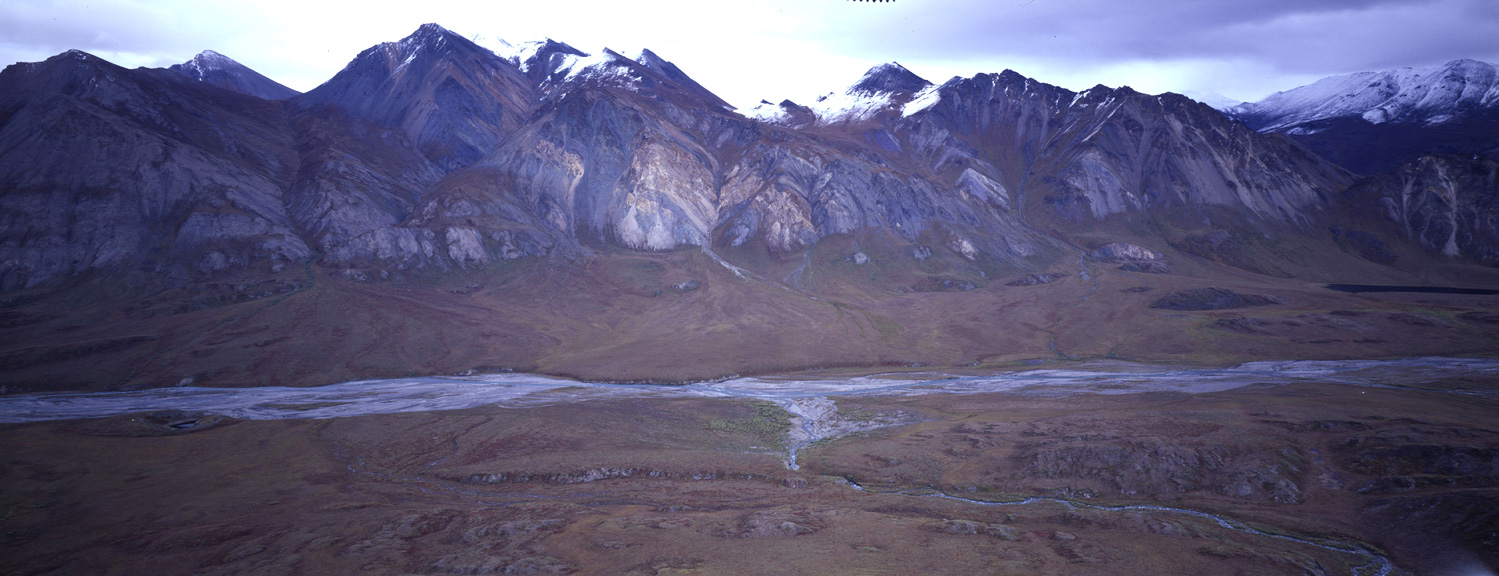Arctic National Wildlife Refuge Project
Endangered Landscapes of the Arctic Refuge with the writings of Olaus and Mardy Murie
Wilderness Photographers Robin W. Radcliffe and Rolfe M. Radcliffe
Ancient rhythms of time and space endure in northeastern Alaska where native peoples still call the Arctic Refuge home. Yet this region is more than their own birthplace, it is the biological heart of a landscape whose cyclic patterns of life and death remain vital to the Gwich'in traditional lifestyle. This land they call Vadzaih googii vi dehk'it gwanlii or "The Sacred Place Where Life Begins" (Arctic Refuge: A Circle of Testimony. 2001 Milkweed Editions).
The Arctic National Wildlife Refuge (ANWR) is a 19.6 million acre wilderness heritage in Alaska's northeastern corner. The Muries, Olaus and Margaret, were early champions for preservation of this natural wild treasure. In part because of their diligent work, the first lands were set-aside in 1960 as the Arctic Range. Twenty years later President Jimmy Carter signed the ANILCA legislation in effect doubling the wilderness area of ANWR. Yet a quarter of a century has passed and the wilderness character of this land, and in particular a key piece named Section 1002 after the legal provision which today still anchors the land designation in limbo, remains in jeopardy as the debate wages over harvest of energy reserves on the one hand and wilderness value on the other. Despite this legacy, now more than ever we are asked to justify this singular jewel as worthy of our most stringent protection and admiration to congressional leaders and our nations people. We believe it is a place far more valuable to people as a protected wilderness area than as a petroleum reserve. Perhaps "Mardy" Murie best voiced these values when she said:
"I am testifying as an emotional woman and I would like to ask you, gentlemen, what's wrong with emotion? Beauty is a resource in and of itself. Alaska must be allowed to be Alaska, that is her greatest economy. I hope the United States of America is not so rich that she can afford to let these wildernesses pass by, or so poor she cannot afford to keep them." (Alaska Lands Act Hearing, Sept. 1964)
Much has been written and photographed of this region. These works have provided useful documentaries of this threatened land, yet few have ventured further - to portray ANWR through fine art. The large-format image is very special. The grandeur of the large format print, as Ansel Adams so eloquently envisioned, remains unmatched. The very nature of the large format photograph lends itself most readily to a contemplative view of landscapes before the lens. The intricate detail of nature and in particular the spectacular and hidden beauty of Alaska's arctic slope within ANWR is well suited to its portrayal on the ground glass of our large format cameras. We portray arctic landscapes on large format color transparency films and finely print each image on archival Cibachrome paper. Exhibits include standard and panoramic prints for display in selected museums.
Our field photographic outfit includes professional large-format field cameras in 4x5, 4x10 and 8x10 formats. Yet the large size and cumbersome nature of these cameras has limited any approach to define this land in larger format, because moving and setting up such equipment in remote wilderness is difficult. Years of preparations have gone into facilitating this work in remote regions and our gear reflects these constraints. Each large format camera is carefully packed in expedition waterproof backpacks that include everything needed for a day's photographic exploration. This includes camera with exchangeable bellows, an assortment of large-format lenses, film holders, sheet film, film changing tent, light meters, focusing loupe, filters, and miscellaneous items. A tripod is lashed to each backpack. We travel down wild rivers by raft and hike from base camps to capture the character of the land.
Joining with the Murie Center, a non-profit organization sharing a similar mission of educating people about the value of wilderness, essays will accompany our ANWR portfolios from the well-respected conservation team of Margaret and Olaus Murie in honor of their life and singular contributions to Alaskan conservation. A selected short essay from the Murie writings will accompany each image. We believe combining the Muries' thoughts and experiences will lend a vibrant and historical voice to our message by providing recollections to complement the large format portfolios.
Our project's ultimate goal is to help secure wilderness designation for ANWR. We believe public education through art and science is the foundation for protecting this important resource for our children.


